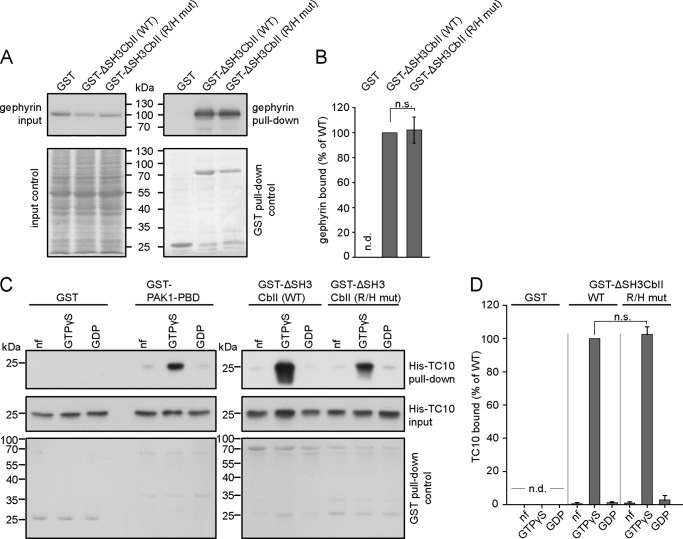FIGURE 3.
The ΔSH3CbII R/H mutant retains its binding to Gephyrin and to active TC10. A, Triton X-100 extracts from adult mouse brain were incubated with the indicated recombinant proteins bound to glutathione-Sepharose beads. Bound native Gephyrin was detected by Western blotting using the 3B11 antibody (1:3,000; Synaptic Systems). Top right panel, note that Gephyrin bound similarly well to GST-ΔSH3CbII WT and the GST-ΔSH3CbII R/H mutant, but not to GST alone. Bottom right panel, MemCode stainings of the same membrane prior to Gephyrin immunoblotting was used to assess the amounts of purified GST and GST-tagged bait proteins used. Left, MemCode staining (bottom panel) and immunoblotting (top panel) of the same membrane was used to ensure that similar amounts of total protein and total Gephyrin were present in all reaction mixtures. B, relative band intensities (Gephyrin pulled down/total Gephyrin, normalized to Cb in MemCode) of Gephyrin bound to GST, GST-ΔSH3CbII WT, or the GST-ΔSH3CbII R/H mutant (n = 3 experiments). Statistical significance was compared between ΔSH3CbII WT and ΔSH3CbII R/H mutant. No binding of Gephyrin to GST was observed. The data represent means ± S.E. n.d., not detectable; n.s., not significant (unpaired, two-tailed Student's t test). C, purified His-TC10, either nucleotide-free or preloaded with GTPγS or GDP, was incubated with the indicated recombinant proteins bound to glutathione-Sepharose beads. Bound His-TC10 was detected by Western blotting using a TC10-specific polyclonal antibody (T8950, 1:4,000; Sigma-Aldrich). Note that GST-ΔSH3CbII WT and the GST-ΔSH3CbII R/H mutant bound preferentially to GTPγS-TC10, as did GST-PAK1-PBD but not GST alone (top panel). Bottom panel, MemCode stainings of the same membranes prior to TC10 immunoblotting indicating the amounts of the GST-tagged bait proteins used in the actual reaction mixture. Middle panel, to ensure that similar amounts of His-TC10 were included in all reaction mixtures, 2% of the premixed reactions were stored and subsequently subjected to anti-TC10 Western blotting using the T8950 antibody. D, relative band intensities (pulled down His-TC10/total His-TC10, normalized to GST-tagged bait proteins in MemCode) of TC10 bound to GST or the GST-ΔSH3CbII R/H mutant, as compared with those of the corresponding TC10 (nucleotide-free, GDPγS, or GDP-loaded) bound to GST-ΔSH3CbII WT (n = 3 experiments). Statistical significance was compared between ΔSH3CbII WT and ΔSH3CbII R/H mutant. No binding of His-TC10 to GST was observed. The data represent means ± S.E. n.d., not detectable; n.s., not significant (unpaired, two-tailed Student's t test).

